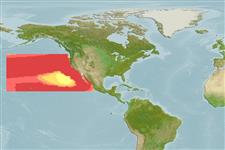分類 / Names
俗名 | 同種異名 | Catalog of Fishes(屬, 種) | ITIS | CoL | WoRMS | Cloffa
Teleostei >
Anguilliformes (Eels and morays)
鰻鱺目 (Eels and morays) >
Nemichthyidae (Snipe eels)
線鰻科 (Snipe eels)
Etymology: Nemichthys: Greek, nema, -atos = filament + Greek, ichthys = fish (Ref. 45335); larseni: Named for Verner Larsen, who began the study of this species while at the University of Copenhagen..
More on authors: Nielsen & Smith.
Environment: milieu / climate zone / depth range / distribution range
生態學
海洋 深海區的; 深度上下限 170 - 1280 m (Ref. 96339). 深水域; 47°N - 17°N, 170°E - 105°W
Eastern Pacific: Oregon, USA to central Mexico, including the Gulf of California; also Hawaii and north of Hawaii to about 38°N.
東太平洋: 美國的奧勒岡州到墨西哥中部, 包括加州灣; 也夏威夷與夏威夷北方到大約 38個 ° N.
大小 / 重量 / 年齡
Maturity: Lm ? range ? - ? cm
Max length : 161 cm TL 雄魚/尚未辨別雌雄; (Ref. 40789)
簡短描述
型態特徵 | 形態測量圖
背的軟條 (總數): 173-222; 臀鰭軟條: 164 - 208. Most easily distinguished from N. scolopaceus by its pale color; has more postorbital and preopercular pores. Rectangle formed by the lateral line pores is shorter and higher than in scolopaceus. Resembles N. curvirostris in its pale color but the subcutaneous dark bars are not as evident. May be instantly distinguished from curvirostris by the more numerous postorbital and preopercular pores and the much shorter and higher rectangle formed by the lateral line pores. Has smaller teeth than curvirostris.
最容易用它的灰白顏色與 N. scolopaceus 區分了; 有更眼眶後的與前鰓蓋骨孔。 由側線孔形成的長方形更短與更高超過在 scolopaceus 中. 在它的灰白顏色中與 N. curvirostris 相似,但是皮下的深色橫帶不是一樣明顯的。 能立即與 curvirostris 區分了藉由眾多的眼眶後的與前鰓蓋骨孔與比較短與比較高很多長方形由側線孔形成了。 超過 curvirostris 有較小的齒。
Mesopelagic (Ref. 58302). Minimum depth from Ref. 58018.
Life cycle and mating behavior
成熟度 | 繁殖 | 產卵場 | 卵 | 孕卵數 | 仔魚
東太平洋: 美國的奧勒岡州到墨西哥中部, 包括加州灣; 也夏威夷與夏威夷北方到大約 38個 ° N.
Nielsen, J.G. and D.G. Smith, 1978. The eel family Nemichthyidae (Pisces, Anguilliformes). Carlsberg Found., Dana-Rept. No. 88:71 p. (Ref. 7450)
IUCN 瀕危狀態 (Ref. 130435)
無危 (LC) ; Date assessed: 28 November 2019
人類使用
更多資訊
俗名同種異名新陳代謝捕食者生態毒物學繁殖成熟度產卵場產卵群集孕卵數卵卵發育
年龄/大小成長長度-重量長度-長度長度-頻率形態測量圖型態特徵仔魚稚魚動力學入添量豐度BRUVS
參考文獻養殖養殖資訊品種遺傳學Electrophoreses遺傳率疾病加工NutrientsMass conversion
合作者照片Stamps, Coins Misc.聲音神經毒速度泳型鰓區Otoliths腦重體重比眼睛色素
工具
特別的報告
下載 XML
網路資源
Estimates based on models
Preferred temperature (Ref.
123201): 6.8 - 7.9, mean 7.4 °C (based on 6 cells).
Phylogenetic diversity index (Ref.
82804): PD
50 = 0.6270 [Uniqueness, from 0.5 = low to 2.0 = high].
Bayesian length-weight: a=0.00102 (0.00046 - 0.00225), b=3.06 (2.88 - 3.24), in cm total length, based on all LWR estimates for this body shape (Ref.
93245).
營養階層 (Ref.
69278): 3.5 ±0.5 se; based on size and trophs of closest relatives
回復力 (Ref.
120179): 低的, 最小族群倍增時間4.5 - 14 年 (Assuming tmax>10).
Fishing Vulnerability (Ref.
59153): Very high vulnerability (90 of 100).
